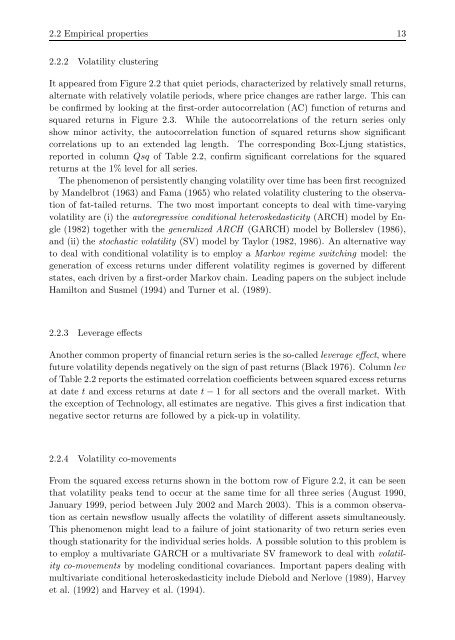Applications of state space models in finance
Applications of state space models in finance
Applications of state space models in finance
Create successful ePaper yourself
Turn your PDF publications into a flip-book with our unique Google optimized e-Paper software.
2.2 Empirical properties 13<br />
2.2.2 Volatility cluster<strong>in</strong>g<br />
It appeared from Figure 2.2 that quiet periods, characterized by relatively small returns,<br />
alternate with relatively volatile periods, where price changes are rather large. This can<br />
be confirmed by look<strong>in</strong>g at the first-order autocorrelation (AC) function <strong>of</strong> returns and<br />
squared returns <strong>in</strong> Figure 2.3. While the autocorrelations <strong>of</strong> the return series only<br />
show m<strong>in</strong>or activity, the autocorrelation function <strong>of</strong> squared returns show significant<br />
correlations up to an extended lag length. The correspond<strong>in</strong>g Box-Ljung statistics,<br />
reported <strong>in</strong> column Qsq <strong>of</strong> Table 2.2, confirm significant correlations for the squared<br />
returns at the 1% level for all series.<br />
The phenomenon <strong>of</strong> persistently chang<strong>in</strong>g volatility over time has been first recognized<br />
by Mandelbrot (1963) and Fama (1965) who related volatility cluster<strong>in</strong>g to the observation<br />
<strong>of</strong> fat-tailed returns. The two most important concepts to deal with time-vary<strong>in</strong>g<br />
volatility are (i) the autoregressive conditional heteroskedasticity (ARCH) model by Engle<br />
(1982) together with the generalized ARCH (GARCH) model by Bollerslev (1986),<br />
and (ii) the stochastic volatility (SV) model by Taylor (1982, 1986). An alternative way<br />
to deal with conditional volatility is to employ a Markov regime switch<strong>in</strong>g model: the<br />
generation <strong>of</strong> excess returns under different volatility regimes is governed by different<br />
<strong>state</strong>s, each driven by a first-order Markov cha<strong>in</strong>. Lead<strong>in</strong>g papers on the subject <strong>in</strong>clude<br />
Hamilton and Susmel (1994) and Turner et al. (1989).<br />
2.2.3 Leverage effects<br />
Another common property <strong>of</strong> f<strong>in</strong>ancial return series is the so-called leverage effect, where<br />
future volatility depends negatively on the sign <strong>of</strong> past returns (Black 1976). Column lev<br />
<strong>of</strong> Table 2.2 reports the estimated correlation coefficients between squared excess returns<br />
at date t and excess returns at date t − 1 for all sectors and the overall market. With<br />
the exception <strong>of</strong> Technology, all estimates are negative. This gives a first <strong>in</strong>dication that<br />
negative sector returns are followed by a pick-up <strong>in</strong> volatility.<br />
2.2.4 Volatility co-movements<br />
From the squared excess returns shown <strong>in</strong> the bottom row <strong>of</strong> Figure 2.2, it can be seen<br />
that volatility peaks tend to occur at the same time for all three series (August 1990,<br />
January 1999, period between July 2002 and March 2003). This is a common observation<br />
as certa<strong>in</strong> newsflow usually affects the volatility <strong>of</strong> different assets simultaneously.<br />
This phenomenon might lead to a failure <strong>of</strong> jo<strong>in</strong>t stationarity <strong>of</strong> two return series even<br />
though stationarity for the <strong>in</strong>dividual series holds. A possible solution to this problem is<br />
to employ a multivariate GARCH or a multivariate SV framework to deal with volatility<br />
co-movements by model<strong>in</strong>g conditional covariances. Important papers deal<strong>in</strong>g with<br />
multivariate conditional heteroskedasticity <strong>in</strong>clude Diebold and Nerlove (1989), Harvey<br />
et al. (1992) and Harvey et al. (1994).

















